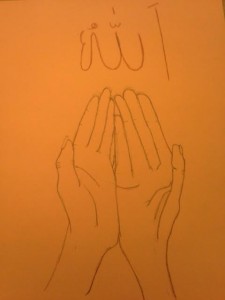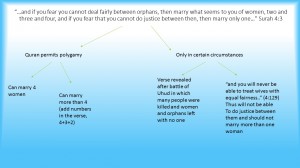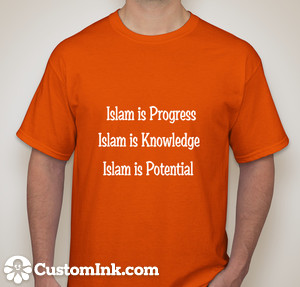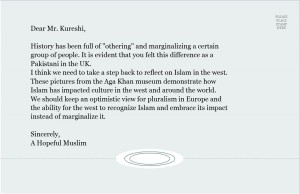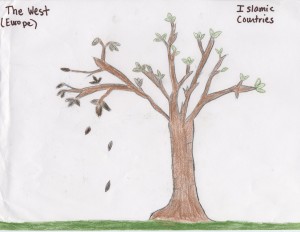Introduction
ø
View my introductory essay below or in this document
Key Themes in Muslim Voices in Contemporary World Literatures
In this class, we travelled around the world, from South Asia to Europe to Africa to the Middle East. We explored issues and topics relating to Islam, culture, and traditions and how they are expressed through prominent literary pieces from the regions. Through my portfolio responses, I reflected on these ideas and how they relate to my own life as a Muslim living in the United States. I learned so much about Islam as a broad term and how it is practiced in so many different countries, uncovering ideas that I had never realized about culture, authority, social justice, and extremism and their relation to Islam. I believe that these concepts are very important to understand and contemplate our diverse and vibrant society.
I discovered that there are many differing views even within Islam. Islam itself cannot take action, Islam is not able to make a decision, rather people are the ones who take certain views and act in specific ways. It can be easy to make claims such as “Islam encourages terrorism” or “Islam says women must wear a veil”, but it reality it is important to remember that Islam is not an actor and cannot actually say or do anything. The way in which people interpret Islamic ideas affect how they act and what they do. I grew up with a certain view of Islam, and I expected most Muslims to have the same views I did. Taking this seminar opened my eyes to the breadth of contrasting interpretations within the same religion of Islam. Islam in India is very different from Islam in Senegal, and even within the same area people can have multiple views on the same topic. This is an overarching theme that has been prevalent in almost every story we have read. I highlighted this idea in my responses to We Sinful Women, The Rainbow Sign, and The Suns of Independence. We Sinful Women demonstrates how women and men can have differing ideas on how a verse of the Quran could be interpreted, and the need for a gender-neutral reading of the text to promote equality. In The Rainbow Sign, tensions between countries are evident and the treatment of Islam in different parts of the world is brought to the forefront of the concept of an Islamic identity, which I contemplated by writing a postcard emphasizing the diversity of Islam. The Suns of Independence showcases Islam in Africa and how culture and Islam can be interwoven, affecting how one views elements of the religion, and I painted Islam as an umbrella encompassing these factors to represent this. In all of these reflections, it is evident that Islam is such a broad category that cannot be simply categorized as one viewpoint.
Important to this idea of differing opinions are the Quran and Prophet Muhammad (pbuh), central aspects of Islam. The Quran originally functioned as an oral text during the time of the Prophet, and was later written down under a Caliph. Each Muslim has a different experience with the Quran, and there are different ways to recite the Quran out loud. Hearing a recitation is an experience within itself connecting one closer to God. In addition to the auditory element, calligraphy and visual features are key aspects of the experience with the Quran. In my response to An Egyptian Childhood, I highlighted the experience I had with Quranic verses around my home. The Quran is central to Islam and has a different effect on each person. Likewise, people view the Prophet Muhammad (pbuh) in a variety of ways. The Prophet exemplified the Quran in his own life, and people have connected the Prophet to many other prominent figures in history. The interpretation of the Prophet is connected to the context throughout history. We highlighted the various connections made to the Prophet in our discussion of The Suns of Independence, in which the African tribes interpreted religious ideas with traditional tribal customs. I reflected on this wide variety of customs relating to the umbrella term of Islam in my response to The Suns of Independence. In China, some Muslims connect the Prophet to Confucious, and in Bangladesh, the Prophet is connected to the 10th Avatara of the god Vishnu—the interpretations of the Prophet differ for different areas of the world.
While the Quran and the Prophet are key to all Muslims, different sects of Islam have different structures of authority following the Prophet. The source of authority for Sunni Muslims are the Ulama, or scholars, who learn through discursive knowledge and create a consensus ruling for the society. I reflected on this idea of becoming a scholar with The Egyptian Childhood, because in the story the main character aims to memorize the Quran only to earn the status of sheikh and gain the respect of the title. In contrast with the method of acquiring knowledge of the ulama, the Sufi shaykh has authority from spirituality and enlightenment. The Shia Imam gains authority from spirituality as well as inherited authority as a descendent of the Prophet and Ali. The differing sources of power demonstrate how Islam has branched off after the Prophet Muhammad (pbuh). The conflicting ideas between these branches is displayed in Persepolis. In my response to Persepolis, I highlighted the violence and sadness Marji had to live through in her childhood. This was caused by the oppressive regime of the Shah and the Iranian Revolution. Iran has a long history of conflict between regimes that claimed to hold religious power, such as the Shah Ismail who claimed to be a descendent of the 12th Imam. The Shah Muhammad Reza Shah wanted to modernize Iran and become secular, but opposition rose against him and reinstated religious control. In this way, power struggles have been a major aspect of religion in countries.
Religious authority can stem from issues of social justice. Inequality in both Muslim and non-Muslim countries has been a consistent theme in the course. One lens of inequality we examined deeply is gender disparity. Many people may generalize and claim that Islam is a religion that oppresses women. However, Muslim countries vary in treatment of women, from Indonesia where women have many rights to Saudi Arabia where women cannot drive. It is unfair to make a broad claim about Islam. It is clear that women in Islam have come to the forefront of the Islamic debate: in We Sinful Women, feminist Pakistani poems portray a previously suppressed view that women should not be silenced and pressured, and in Sultana’s Dream the other extreme of locking men away is presented. My response to We Sinful Women explains how a patriarchal view of the Quran may have been the precedent in the past, but women are now calling for a more equal reading. I focused on two major issues, polygamy and the veil, and described how there can be restrictive or liberating views on each topic. Some people view Islam as a method towards treating women equally, and others perpetuate a patriarchal interpretation of Islam. Women are often pressured by society to act in a certain way, often based on religion. In India, women are held to high standards of modesty and honor, unlike their male counterparts, and can be valued only for their virtue. Madras on Rainy Days examines this idea and the inability of society to accept anyone who is different. Layla, the protagonist in the novel, is thought to be possessed by the devil when she no longer wants to get married. In my response to the novel, I reflected on the concepts of shame and honor and how we must appreciate women as people and not objectify them.
Inequality is also present in the treatment of the poor. Too often the minority is oppressed and kept in a state of poverty. In The Beggar’s Strike, the community realizes the importance of the beggars and the need to treat them with kindness after kicking them off the streets simply for appearance. I reflected on this idea by comparing begging on the streets with begging to God. It is important to have compassion for others and recognize what they are going through. Similarly, in Children of the Alley, the families not in power must live in poverty. While sometimes a leader rises up and promotes peace in the alley, the peace is short-lived and the alley returns to a poor and unequal society. I reflected on this by constructing the cycle of oppression present in the book. Prophets and religion were not able to create a lasting peace in the alley. The idea of corruption in a society is a very real possibility and is present in the oppressive regimes we see around the world.
Oppression and extremism have become an increasingly larger part of the conversation surrounding Islam with the emerging of radical and terrorist groups such as Al-Qaeda and ISIS that act in the name of Islam. Some people have started treating Islam as an ideology for violence and tyranny, and view the West as an enemy against Islam. This theme of Islam vs. the West has been prevalent throughout the course. In The Saint’s Lamp, the protagonist Ismail leaves Egypt and goes to Europe for his studies, but loses his faith and belief in Islam and the power of Umm Hashim’s oil lamp to cure sickness. The West is seen as a corrupting force that causes people to lose their faith. In The Rainbow Sign, it is evident that the English discriminated against Pakistani Muslims and considered them “the other”. It is this feeling of marginalization and exclusion that can drive people to join extremist groups, desperate for a sense of community and the feeling of being a true member of a group. In my reflections, I tried to encourage pluralism and realizing that there does not need to be this dichotomy between Muslim countries and western countries. As a Muslim who grew up in America of Indian and Pakistani background, I have a strong identity rooted in American ideals but also believe in Islam. To some, this combination is impossible, but I believe that Islam and the West can be peaceful together if we keep an open mind, embrace other cultures, and do not stereotype either side. The Pakistani poet Iqbal viewed Islam as progress and thought that westerners were actually those who were acting as Muslims in spirit, by encouraging pursuit of knowledge and development. In my reflection, I created a t-shirt portraying these ideas to bring this concept of intertwining Islam with advancement to a modern platform. Among so much discrimination and stereotyping in the world today, it is important to keep the idea of building bridges across different cultures in the forefront of our actions.
Throughout my portfolio, I examine these issues plaguing our world today and use painting, drawing, writing, and digital technology to contemplate them. The underlying themes of the differing views under the term ‘Islam’ and an Islamic identity in different countries and contexts will always be applicable to the world around me. Voices have spoken out about these ideas through literature around the world, and I know these concepts will stay with me as I hear more about Islam in the news and media. As Islam or any religion or outlook can be presented with a bias, it is increasingly important to learn more about the reasoning behind actions and beliefs. I am happy that I was able to learn so much about different worldviews and how they apply to my own life, and I know that I now more fully appreciate different cultures and interpretations.
